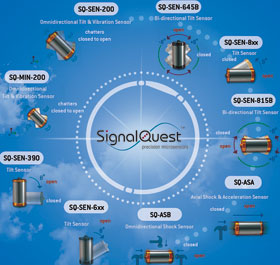

SignalQuest designs and manufactures electronic sensors that measure tilt angle, vibration, shock, acceleration and movement as well as application specific inertial measurement devices.
The SQ-ASB series sensor is a normally closed omnidirectional shock sensor which is roughly four times more sensitive off-axis than on-axis. Typical cross-axis open signals are in the 2 – 8 mS range, where on-axis open signals are proportional to the duration of acceleration above the threshold. If better accuracy is required, designers can choose the cross-axis specification that matches their requirements and use two sensors at right angles to one another, logically OR’d together.
The SQ-MIN-200 acts like a normally closed switch which chatters open and closed as it is tilted or vibrated. Unlike other rolling-ball sensors, it is a truly omnidirectional movement sensor that will function regardless of how it is mounted or aligned.
When at rest, the sensor normally settles in a closed state. When in motion, it will produce continuous on/off contact closures. It is sensitive to both tilt (static acceleration) and vibration (dynamic acceleration). The SQ-MIN-200 can be used to produce a series of CMOS or TTL logic level or pulse train using a single resistor to limit current. The signal level can be read directly by a digital input.
This can be used to interrupt (wake up) a microcontroller or can be counted to estimate the amount and duration of activity. The sensor is fully passive, requires no signal conditioning, and draws as little as 50 nA of continuous current.
SQ-SEN-6xx series tilt sensors act like a position sensitive switch that is normally open when vertical and normally closed below or between the switch angles. They are designed to be non-sensitive to vibration or lateral movement when vertical.
When at rest in a vertical position, the sensor will settle in an open state. When tipped down from vertical to the ‘switch angle’ it will produce continuous on/off contact closures while in motion. When at rest below or between the switch angles, it will settle normally closed.
The sensor can be used to produce CMOS or TTL pulses to interrupt a microcontroller. Alternatively, these pulses can be counted to estimate the amount and duration of activity. The sensor is fully passive, requires no signal conditioning, and operates from currents as low as 50 nA.
The SQ-SEN-8xx on/off tilt sensor series acts like a position sensitive switch that is normally open when horizontal and normally closed below the switch angle. It is designed to be non-sensitive to vibration in a horizontal orientation. When at rest in a horizontal orientation, the sensor will settle in an open state. When tipped down from vertical to the switch angle, it will produce continuous on/off contact closures while in motion. When at rest below the switch angle, it will settle normally open.
The SQ-SEN-200 sensor acts like a normally closed switch which chatters open and closed as it is tilted or vibrated. It is an omnidirectional movement sensor that will function regardless of how it is mounted or aligned. When at rest, it normally settles in a closed state, and when in motion, it will produce continuous on/off contact closures.
The sensor is sensitive to both tilt (static acceleration) and vibration (dynamic acceleration). It can be used to produce a series of CMOS or TTL logic level or pulse train using a single resistor to limit current; the signal level can be read directly by a digital input. This can be used to interrupt a microcontroller or can be counted to estimate the amount and duration of activity. The sensor is fully passive, requires no signal conditioning, and draws as little as 50 nA of continuous current.
SQ-SEN-390 series sensors act like a position sensitive switch which is normally closed when below horizontal and normally open when above horizontal. When at rest, they normally settle in a closed state, and when in motion, they will produce continuous on/off contact closures. They are sensitive to both tilt and vibration.
The sensors can produce a series of CMOS or TTL logic level or pulse train using a single resistor to limit current and the signal level can be read directly by a digital input. This can be used to interrupt a microcontroller or can be counted to estimate the amount and duration of activity. The sensor is fully passive, requires no signal conditioning, and draws as little as 50 nA of continuous current.
For more information contact Andrew Hutton, RF Design, +27 (0)21 555 8400, [email protected], www.rfdesign.co.za
| Tel: | +27 21 555 8400 |
| Email: | [email protected] |
| www: | www.rfdesign.co.za |
| Articles: | More information and articles about RF Design |
© Technews Publishing (Pty) Ltd | All Rights Reserved